Effects of New Larger Aircraft on Airport Management: A Research Paper
VerifiedAdded on 2020/05/28
|11
|2923
|42
Report
AI Summary
This research paper delves into the multifaceted impact of new larger aircraft (NLA) on airport management. It begins by highlighting the challenges posed by the increasing size and capacity of these aircraft, which necessitate significant adjustments to airport design, including runway and taxiway co...
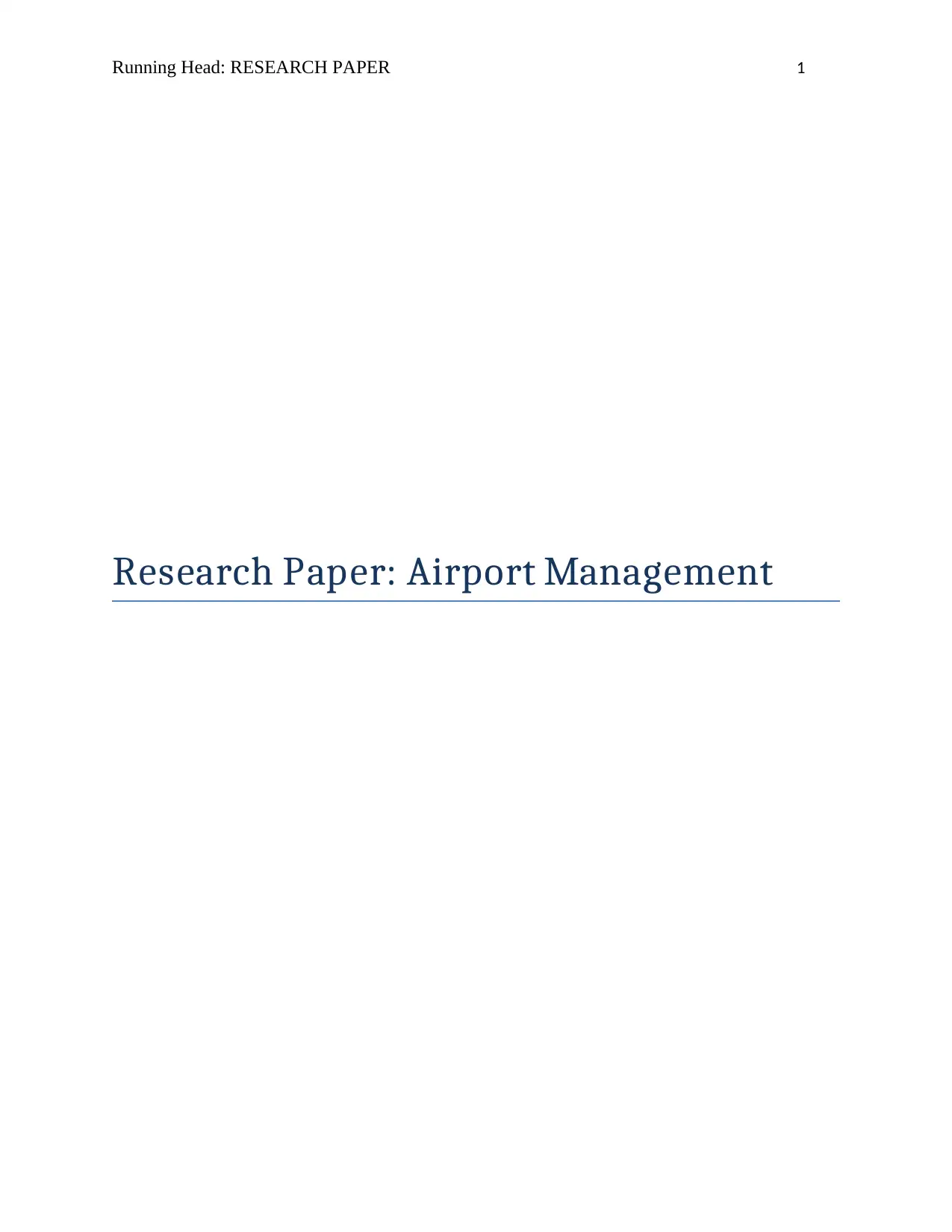
Running Head: RESEARCH PAPER 1
Research Paper: Airport Management
Research Paper: Airport Management
Paraphrase This Document
Need a fresh take? Get an instant paraphrase of this document with our AI Paraphraser
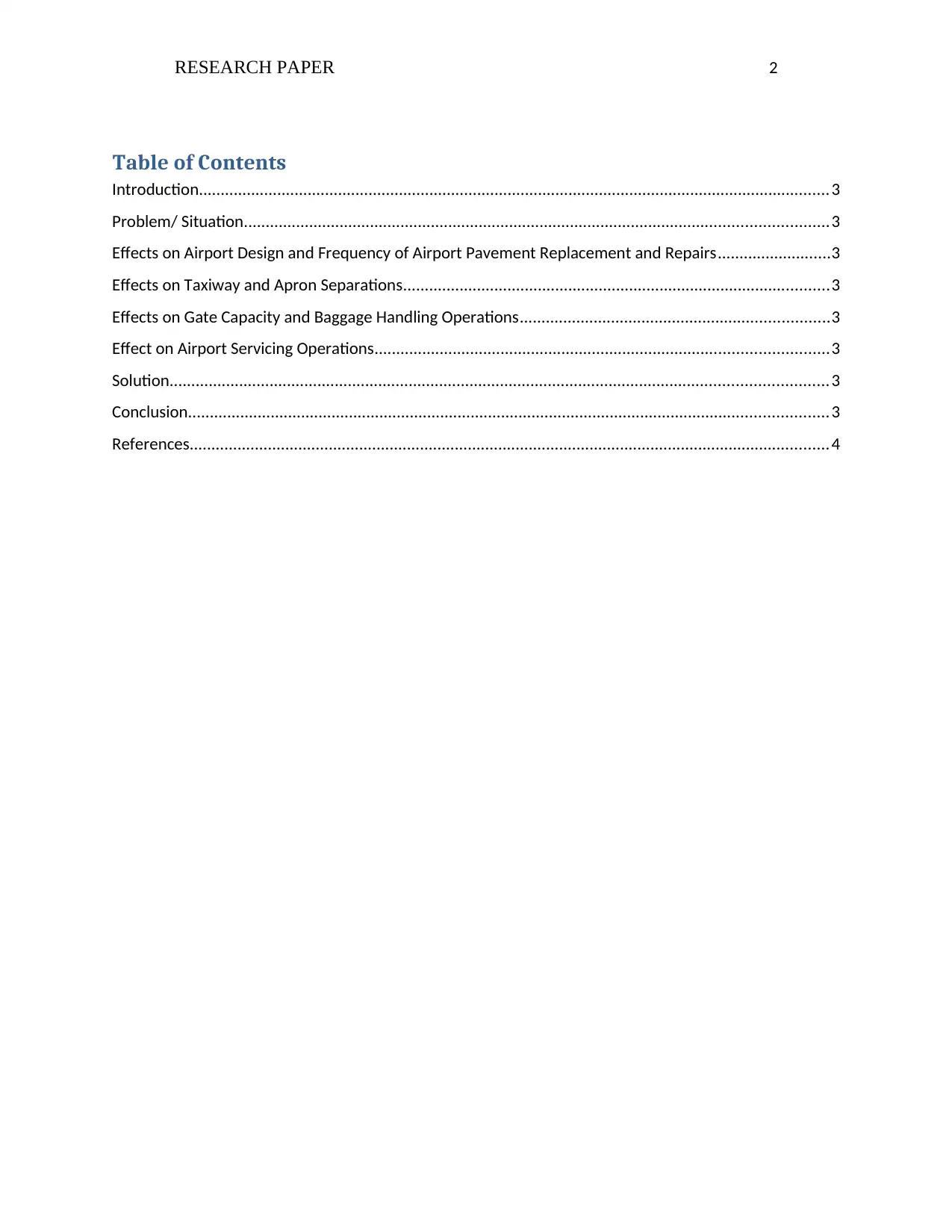
RESEARCH PAPER 2
Table of Contents
Introduction.................................................................................................................................................3
Problem/ Situation......................................................................................................................................3
Effects on Airport Design and Frequency of Airport Pavement Replacement and Repairs..........................3
Effects on Taxiway and Apron Separations..................................................................................................3
Effects on Gate Capacity and Baggage Handling Operations.......................................................................3
Effect on Airport Servicing Operations........................................................................................................3
Solution.......................................................................................................................................................3
Conclusion...................................................................................................................................................3
References...................................................................................................................................................4
Table of Contents
Introduction.................................................................................................................................................3
Problem/ Situation......................................................................................................................................3
Effects on Airport Design and Frequency of Airport Pavement Replacement and Repairs..........................3
Effects on Taxiway and Apron Separations..................................................................................................3
Effects on Gate Capacity and Baggage Handling Operations.......................................................................3
Effect on Airport Servicing Operations........................................................................................................3
Solution.......................................................................................................................................................3
Conclusion...................................................................................................................................................3
References...................................................................................................................................................4

RESEARCH PAPER 3
Introduction
With a forecasted development rate of 5% every year, it is estimated to double air traveller traffic
in next 15 years and triple in the timeframe of next 20 years. To fulfill the demands and needs of
aviation industry, airbus manufacturers have developed a “super jumbo jet” that is known as
larger aircraft. This aircraft has capability to carry 555 to 800 travellers. The term “New Large
Aircraft” is generally utilized to define the new aircrafts, which are being manufactured by
airline industries, which have lengths and wingspans greater than others. First two New Larger
aircrafts, which have entered in airbus industry, were Boeing 777 and A380 (Fielding, 2017).
With greater capacity, these larger aircrafts have modern technology features also. The first
response of management at larger airports was to limit the new large aircraft by allocating them
to specific routes, runways and terminals. This also led to air traffic blocking and delays and it
has large impact on airport management. This paper has the discussion about the effects of these
New Larger Aircraft on different component of airport management.
Problem/ Situation
However the introduction and development of new larger aircraft will make positive changes in
airline industry and generate various advantages, but the major issue with these airbuses is that it
has a significant impact on overall airport design and planning. This issue is recognized the fact
that features and size of aircraft play an important role in airport management process (Wilke,
Majumdar, & Ochieng, 2014). It has impact on different processes, which are stated below;
Effects on Airport Design and Frequency of Airport Pavement
Replacement and Repairs
The major area, through which larger aircraft impacts the airport management, is its impact on
airport design and frequency of airport pavement replacement and repairs. The new larger
aircraft makes a contribution to the length requirement of new runway as length need of actual
runway. It will make changes in layout and size of taxiways and runways (De Neufville, 2016).
To operate new larger aircraft, there will be need for separations of taxiways and runways. On
airport design, the effect of new larger aircraft involves that there will be requirement for
changes in designs of airfield like; dimensions and configuration of runways, aprons and
Introduction
With a forecasted development rate of 5% every year, it is estimated to double air traveller traffic
in next 15 years and triple in the timeframe of next 20 years. To fulfill the demands and needs of
aviation industry, airbus manufacturers have developed a “super jumbo jet” that is known as
larger aircraft. This aircraft has capability to carry 555 to 800 travellers. The term “New Large
Aircraft” is generally utilized to define the new aircrafts, which are being manufactured by
airline industries, which have lengths and wingspans greater than others. First two New Larger
aircrafts, which have entered in airbus industry, were Boeing 777 and A380 (Fielding, 2017).
With greater capacity, these larger aircrafts have modern technology features also. The first
response of management at larger airports was to limit the new large aircraft by allocating them
to specific routes, runways and terminals. This also led to air traffic blocking and delays and it
has large impact on airport management. This paper has the discussion about the effects of these
New Larger Aircraft on different component of airport management.
Problem/ Situation
However the introduction and development of new larger aircraft will make positive changes in
airline industry and generate various advantages, but the major issue with these airbuses is that it
has a significant impact on overall airport design and planning. This issue is recognized the fact
that features and size of aircraft play an important role in airport management process (Wilke,
Majumdar, & Ochieng, 2014). It has impact on different processes, which are stated below;
Effects on Airport Design and Frequency of Airport Pavement
Replacement and Repairs
The major area, through which larger aircraft impacts the airport management, is its impact on
airport design and frequency of airport pavement replacement and repairs. The new larger
aircraft makes a contribution to the length requirement of new runway as length need of actual
runway. It will make changes in layout and size of taxiways and runways (De Neufville, 2016).
To operate new larger aircraft, there will be need for separations of taxiways and runways. On
airport design, the effect of new larger aircraft involves that there will be requirement for
changes in designs of airfield like; dimensions and configuration of runways, aprons and
⊘ This is a preview!⊘
Do you want full access?
Subscribe today to unlock all pages.

Trusted by 1+ million students worldwide

RESEARCH PAPER 4
taxiways. If any airbus manufacturer introduces a new larger aircraft, it will require reviewing
the current airport coding systems like; apron design, airport classification method, pavement
design and airfield geometric design. In addition to this, it will also have impact on air traffic
control and it will enhance the separation requirement between aircrafts, which are approaching
an airport. Moreover, there are some design standards, which are not adequate for increased
needs of new larger aircrafts. There are several airports, which do not have growth opportunities
and they are not able to host New Larger Aircraft without implementing special operational
measures. The airports, which are planning to host larger aircrafts, they need to develop and
enhance their services and facilities to fulfill the airport design standards of FAA (Fife, &
McNerney, 2018).
Moreover, New Larger Aircraft introduction will have considerable effect on frequency of
airport pavement replacement and repairs. It will enhance the frequency of airport pavement
replacement and repairs. This increased frequency will contribute to changes, which are required
for designing pavement. The existing pavement design methods for Boeing 777 aircraft can be
used for designing and assessing the new larger aircraft for other airbus manufacturers. For
pavement design, the aircraft will require thicker and stronger pavement and some specific
design standards, which can increase the size of aircraft. If the pavement designs will not be
thicker and stronger, then there will be need of more repairs and replacement as new larger
aircraft will be heavier than traditional aircrafts (Gubenko & Ksenofontova, 2015).
Effects on Taxiway and Apron Separations
Apart from the impact on design of airport, New Larger Aircraft will have a significant effect on
apron and taxiway separations. Taxiways and runways are needed to be appropriate dimensions
on the basis of largest aircraft estimated to utilize them. Introduction of New Larger Aircraft
need a taxiway bridge that meets clearance and its width requirements. First, this new aircraft
will affect the taxiway design standards due to its larger size. If the existing standards will be
followed, the airplane will have adverse impact on safety of neighboring terminal areas, taxiways
and runways (Wu, 2016). Thus, effective functioning of new larger aircraft will require
broadening and relocating the taxiways and restricting its operations to particular duration of low
traffic, so that it can improve the airport safety and develop enough clearance.
taxiways. If any airbus manufacturer introduces a new larger aircraft, it will require reviewing
the current airport coding systems like; apron design, airport classification method, pavement
design and airfield geometric design. In addition to this, it will also have impact on air traffic
control and it will enhance the separation requirement between aircrafts, which are approaching
an airport. Moreover, there are some design standards, which are not adequate for increased
needs of new larger aircrafts. There are several airports, which do not have growth opportunities
and they are not able to host New Larger Aircraft without implementing special operational
measures. The airports, which are planning to host larger aircrafts, they need to develop and
enhance their services and facilities to fulfill the airport design standards of FAA (Fife, &
McNerney, 2018).
Moreover, New Larger Aircraft introduction will have considerable effect on frequency of
airport pavement replacement and repairs. It will enhance the frequency of airport pavement
replacement and repairs. This increased frequency will contribute to changes, which are required
for designing pavement. The existing pavement design methods for Boeing 777 aircraft can be
used for designing and assessing the new larger aircraft for other airbus manufacturers. For
pavement design, the aircraft will require thicker and stronger pavement and some specific
design standards, which can increase the size of aircraft. If the pavement designs will not be
thicker and stronger, then there will be need of more repairs and replacement as new larger
aircraft will be heavier than traditional aircrafts (Gubenko & Ksenofontova, 2015).
Effects on Taxiway and Apron Separations
Apart from the impact on design of airport, New Larger Aircraft will have a significant effect on
apron and taxiway separations. Taxiways and runways are needed to be appropriate dimensions
on the basis of largest aircraft estimated to utilize them. Introduction of New Larger Aircraft
need a taxiway bridge that meets clearance and its width requirements. First, this new aircraft
will affect the taxiway design standards due to its larger size. If the existing standards will be
followed, the airplane will have adverse impact on safety of neighboring terminal areas, taxiways
and runways (Wu, 2016). Thus, effective functioning of new larger aircraft will require
broadening and relocating the taxiways and restricting its operations to particular duration of low
traffic, so that it can improve the airport safety and develop enough clearance.
Paraphrase This Document
Need a fresh take? Get an instant paraphrase of this document with our AI Paraphraser
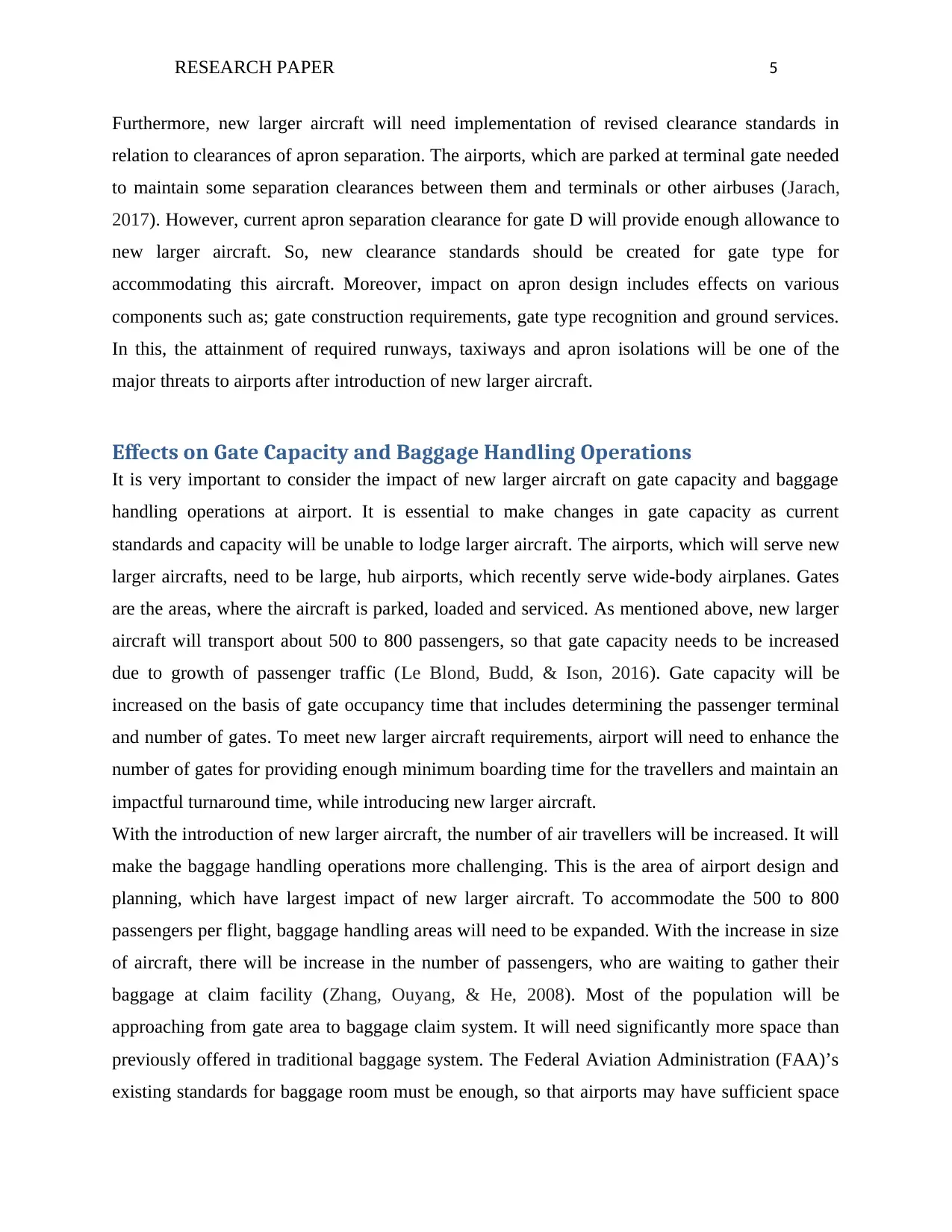
RESEARCH PAPER 5
Furthermore, new larger aircraft will need implementation of revised clearance standards in
relation to clearances of apron separation. The airports, which are parked at terminal gate needed
to maintain some separation clearances between them and terminals or other airbuses (Jarach,
2017). However, current apron separation clearance for gate D will provide enough allowance to
new larger aircraft. So, new clearance standards should be created for gate type for
accommodating this aircraft. Moreover, impact on apron design includes effects on various
components such as; gate construction requirements, gate type recognition and ground services.
In this, the attainment of required runways, taxiways and apron isolations will be one of the
major threats to airports after introduction of new larger aircraft.
Effects on Gate Capacity and Baggage Handling Operations
It is very important to consider the impact of new larger aircraft on gate capacity and baggage
handling operations at airport. It is essential to make changes in gate capacity as current
standards and capacity will be unable to lodge larger aircraft. The airports, which will serve new
larger aircrafts, need to be large, hub airports, which recently serve wide-body airplanes. Gates
are the areas, where the aircraft is parked, loaded and serviced. As mentioned above, new larger
aircraft will transport about 500 to 800 passengers, so that gate capacity needs to be increased
due to growth of passenger traffic (Le Blond, Budd, & Ison, 2016). Gate capacity will be
increased on the basis of gate occupancy time that includes determining the passenger terminal
and number of gates. To meet new larger aircraft requirements, airport will need to enhance the
number of gates for providing enough minimum boarding time for the travellers and maintain an
impactful turnaround time, while introducing new larger aircraft.
With the introduction of new larger aircraft, the number of air travellers will be increased. It will
make the baggage handling operations more challenging. This is the area of airport design and
planning, which have largest impact of new larger aircraft. To accommodate the 500 to 800
passengers per flight, baggage handling areas will need to be expanded. With the increase in size
of aircraft, there will be increase in the number of passengers, who are waiting to gather their
baggage at claim facility (Zhang, Ouyang, & He, 2008). Most of the population will be
approaching from gate area to baggage claim system. It will need significantly more space than
previously offered in traditional baggage system. The Federal Aviation Administration (FAA)’s
existing standards for baggage room must be enough, so that airports may have sufficient space
Furthermore, new larger aircraft will need implementation of revised clearance standards in
relation to clearances of apron separation. The airports, which are parked at terminal gate needed
to maintain some separation clearances between them and terminals or other airbuses (Jarach,
2017). However, current apron separation clearance for gate D will provide enough allowance to
new larger aircraft. So, new clearance standards should be created for gate type for
accommodating this aircraft. Moreover, impact on apron design includes effects on various
components such as; gate construction requirements, gate type recognition and ground services.
In this, the attainment of required runways, taxiways and apron isolations will be one of the
major threats to airports after introduction of new larger aircraft.
Effects on Gate Capacity and Baggage Handling Operations
It is very important to consider the impact of new larger aircraft on gate capacity and baggage
handling operations at airport. It is essential to make changes in gate capacity as current
standards and capacity will be unable to lodge larger aircraft. The airports, which will serve new
larger aircrafts, need to be large, hub airports, which recently serve wide-body airplanes. Gates
are the areas, where the aircraft is parked, loaded and serviced. As mentioned above, new larger
aircraft will transport about 500 to 800 passengers, so that gate capacity needs to be increased
due to growth of passenger traffic (Le Blond, Budd, & Ison, 2016). Gate capacity will be
increased on the basis of gate occupancy time that includes determining the passenger terminal
and number of gates. To meet new larger aircraft requirements, airport will need to enhance the
number of gates for providing enough minimum boarding time for the travellers and maintain an
impactful turnaround time, while introducing new larger aircraft.
With the introduction of new larger aircraft, the number of air travellers will be increased. It will
make the baggage handling operations more challenging. This is the area of airport design and
planning, which have largest impact of new larger aircraft. To accommodate the 500 to 800
passengers per flight, baggage handling areas will need to be expanded. With the increase in size
of aircraft, there will be increase in the number of passengers, who are waiting to gather their
baggage at claim facility (Zhang, Ouyang, & He, 2008). Most of the population will be
approaching from gate area to baggage claim system. It will need significantly more space than
previously offered in traditional baggage system. The Federal Aviation Administration (FAA)’s
existing standards for baggage room must be enough, so that airports may have sufficient space

RESEARCH PAPER 6
for expanding and meeting these additional necessities. In this way, it will affect the baggage
handling operations (Leone, & Liu, 2011).
Effect on Airport Servicing Operations
In addition to above effects, introduction of new larger will also affect the airport servicing
operations. As discussed above, runways, taxiways and aprons are the major areas in airports,
which will need most of the modifications because of new larger aircraft introduction. Moreover,
the airport authority needs to consider different services of airport operations. There are various
services such as cabin service, customer service, safety and protection, field operation service
and catering services, which need to be handled, while launching a larger aircraft. Additionally,
it requires fulfilling some ground servicing needs for NLAs. These new aircrafts will use
equipment and receptacles, which will be similar to wide body airbuses. All of the components
of passenger and airport service will be affected by increased aircraft capacity (Fayez, Kaylani,
Cope, Rychlik, & Mollaghasemi, 2008). Primarily, three of these operations can be affected, i.e.
arrival and departure lounges, check-in facilities and baggage handling processes. With the
increased capacity, number of check-in counters needs to be increased, if a minimum level of
service is to be attained. The airport authority needs to evaluate the space offered for queues, so
that situation of congestion can be avoided. A recent survey suggested that there should be 10 to
12 check-in counters for larger aircrafts.
Under airport servicing operations, it should be focused on safety and protection of the
passengers and staff, while introducing new larger aircraft. The ability of airport to effectively
and quickly handle an emergency situation is significant safety issue, which will need an
extensive research with the introduction of larger aircraft. With the increase in the size of
aircraft, it is essential to revise the FAA’s standards for safety and protection issues. As NLA
aircrafts run internationally, so it is very important that passengers are screened appropriately
without compromising safety. The airports with larger aircrafts may need to increase their
security stations to facilitate the passengers. It can be done by using extra x-ray machines and
walk through weapon detectors. FAA will require ensuring that airports can conduct screening
processes in most effective manner (Kierzkowski, 2016). The airports, which are expecting to
serve new larger aircraft in future, will require enhancing their existing processes for handling
aircraft emergencies. It will carry more passengers than regular aircraft, so it will need extra
for expanding and meeting these additional necessities. In this way, it will affect the baggage
handling operations (Leone, & Liu, 2011).
Effect on Airport Servicing Operations
In addition to above effects, introduction of new larger will also affect the airport servicing
operations. As discussed above, runways, taxiways and aprons are the major areas in airports,
which will need most of the modifications because of new larger aircraft introduction. Moreover,
the airport authority needs to consider different services of airport operations. There are various
services such as cabin service, customer service, safety and protection, field operation service
and catering services, which need to be handled, while launching a larger aircraft. Additionally,
it requires fulfilling some ground servicing needs for NLAs. These new aircrafts will use
equipment and receptacles, which will be similar to wide body airbuses. All of the components
of passenger and airport service will be affected by increased aircraft capacity (Fayez, Kaylani,
Cope, Rychlik, & Mollaghasemi, 2008). Primarily, three of these operations can be affected, i.e.
arrival and departure lounges, check-in facilities and baggage handling processes. With the
increased capacity, number of check-in counters needs to be increased, if a minimum level of
service is to be attained. The airport authority needs to evaluate the space offered for queues, so
that situation of congestion can be avoided. A recent survey suggested that there should be 10 to
12 check-in counters for larger aircrafts.
Under airport servicing operations, it should be focused on safety and protection of the
passengers and staff, while introducing new larger aircraft. The ability of airport to effectively
and quickly handle an emergency situation is significant safety issue, which will need an
extensive research with the introduction of larger aircraft. With the increase in the size of
aircraft, it is essential to revise the FAA’s standards for safety and protection issues. As NLA
aircrafts run internationally, so it is very important that passengers are screened appropriately
without compromising safety. The airports with larger aircrafts may need to increase their
security stations to facilitate the passengers. It can be done by using extra x-ray machines and
walk through weapon detectors. FAA will require ensuring that airports can conduct screening
processes in most effective manner (Kierzkowski, 2016). The airports, which are expecting to
serve new larger aircraft in future, will require enhancing their existing processes for handling
aircraft emergencies. It will carry more passengers than regular aircraft, so it will need extra
⊘ This is a preview!⊘
Do you want full access?
Subscribe today to unlock all pages.

Trusted by 1+ million students worldwide
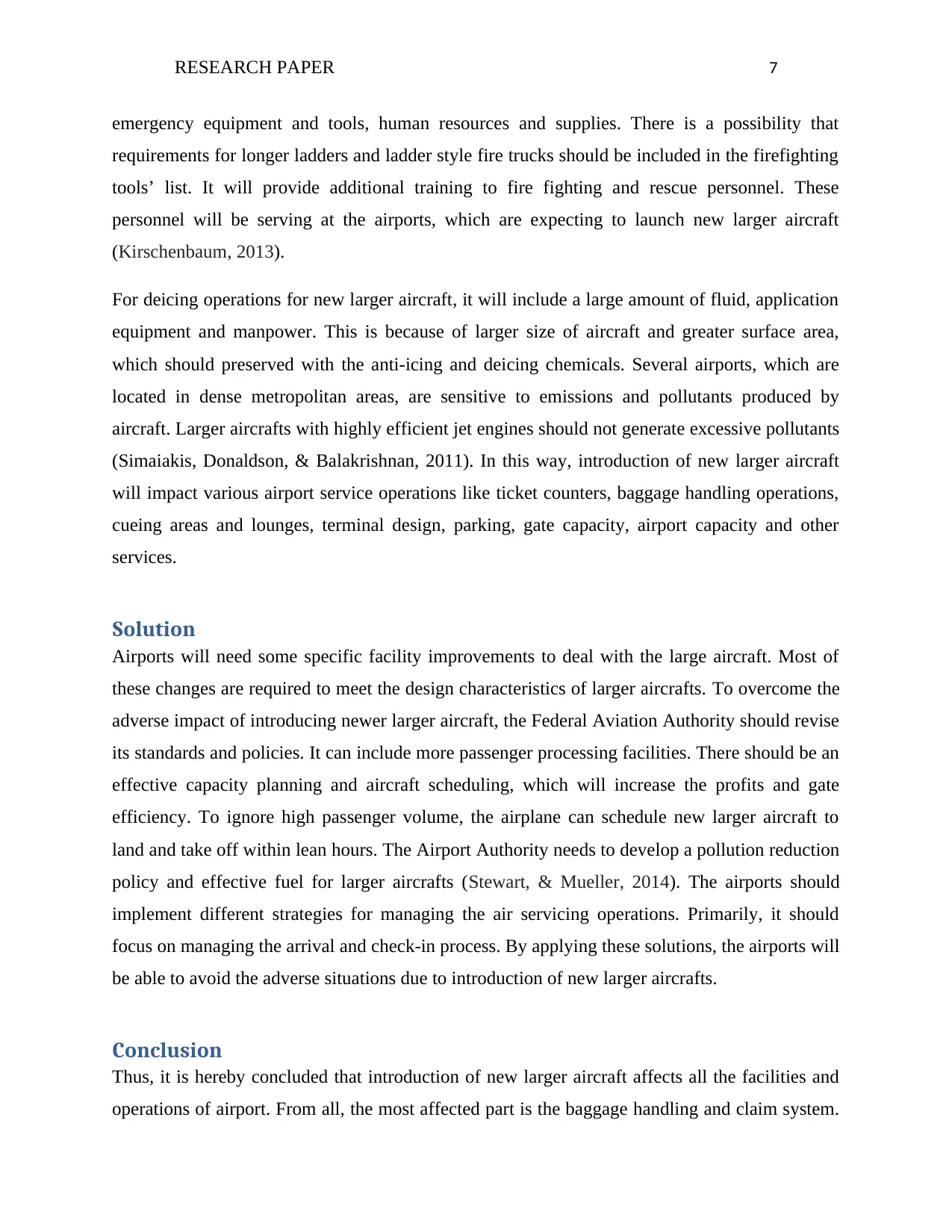
RESEARCH PAPER 7
emergency equipment and tools, human resources and supplies. There is a possibility that
requirements for longer ladders and ladder style fire trucks should be included in the firefighting
tools’ list. It will provide additional training to fire fighting and rescue personnel. These
personnel will be serving at the airports, which are expecting to launch new larger aircraft
(Kirschenbaum, 2013).
For deicing operations for new larger aircraft, it will include a large amount of fluid, application
equipment and manpower. This is because of larger size of aircraft and greater surface area,
which should preserved with the anti-icing and deicing chemicals. Several airports, which are
located in dense metropolitan areas, are sensitive to emissions and pollutants produced by
aircraft. Larger aircrafts with highly efficient jet engines should not generate excessive pollutants
(Simaiakis, Donaldson, & Balakrishnan, 2011). In this way, introduction of new larger aircraft
will impact various airport service operations like ticket counters, baggage handling operations,
cueing areas and lounges, terminal design, parking, gate capacity, airport capacity and other
services.
Solution
Airports will need some specific facility improvements to deal with the large aircraft. Most of
these changes are required to meet the design characteristics of larger aircrafts. To overcome the
adverse impact of introducing newer larger aircraft, the Federal Aviation Authority should revise
its standards and policies. It can include more passenger processing facilities. There should be an
effective capacity planning and aircraft scheduling, which will increase the profits and gate
efficiency. To ignore high passenger volume, the airplane can schedule new larger aircraft to
land and take off within lean hours. The Airport Authority needs to develop a pollution reduction
policy and effective fuel for larger aircrafts (Stewart, & Mueller, 2014). The airports should
implement different strategies for managing the air servicing operations. Primarily, it should
focus on managing the arrival and check-in process. By applying these solutions, the airports will
be able to avoid the adverse situations due to introduction of new larger aircrafts.
Conclusion
Thus, it is hereby concluded that introduction of new larger aircraft affects all the facilities and
operations of airport. From all, the most affected part is the baggage handling and claim system.
emergency equipment and tools, human resources and supplies. There is a possibility that
requirements for longer ladders and ladder style fire trucks should be included in the firefighting
tools’ list. It will provide additional training to fire fighting and rescue personnel. These
personnel will be serving at the airports, which are expecting to launch new larger aircraft
(Kirschenbaum, 2013).
For deicing operations for new larger aircraft, it will include a large amount of fluid, application
equipment and manpower. This is because of larger size of aircraft and greater surface area,
which should preserved with the anti-icing and deicing chemicals. Several airports, which are
located in dense metropolitan areas, are sensitive to emissions and pollutants produced by
aircraft. Larger aircrafts with highly efficient jet engines should not generate excessive pollutants
(Simaiakis, Donaldson, & Balakrishnan, 2011). In this way, introduction of new larger aircraft
will impact various airport service operations like ticket counters, baggage handling operations,
cueing areas and lounges, terminal design, parking, gate capacity, airport capacity and other
services.
Solution
Airports will need some specific facility improvements to deal with the large aircraft. Most of
these changes are required to meet the design characteristics of larger aircrafts. To overcome the
adverse impact of introducing newer larger aircraft, the Federal Aviation Authority should revise
its standards and policies. It can include more passenger processing facilities. There should be an
effective capacity planning and aircraft scheduling, which will increase the profits and gate
efficiency. To ignore high passenger volume, the airplane can schedule new larger aircraft to
land and take off within lean hours. The Airport Authority needs to develop a pollution reduction
policy and effective fuel for larger aircrafts (Stewart, & Mueller, 2014). The airports should
implement different strategies for managing the air servicing operations. Primarily, it should
focus on managing the arrival and check-in process. By applying these solutions, the airports will
be able to avoid the adverse situations due to introduction of new larger aircrafts.
Conclusion
Thus, it is hereby concluded that introduction of new larger aircraft affects all the facilities and
operations of airport. From all, the most affected part is the baggage handling and claim system.
Paraphrase This Document
Need a fresh take? Get an instant paraphrase of this document with our AI Paraphraser
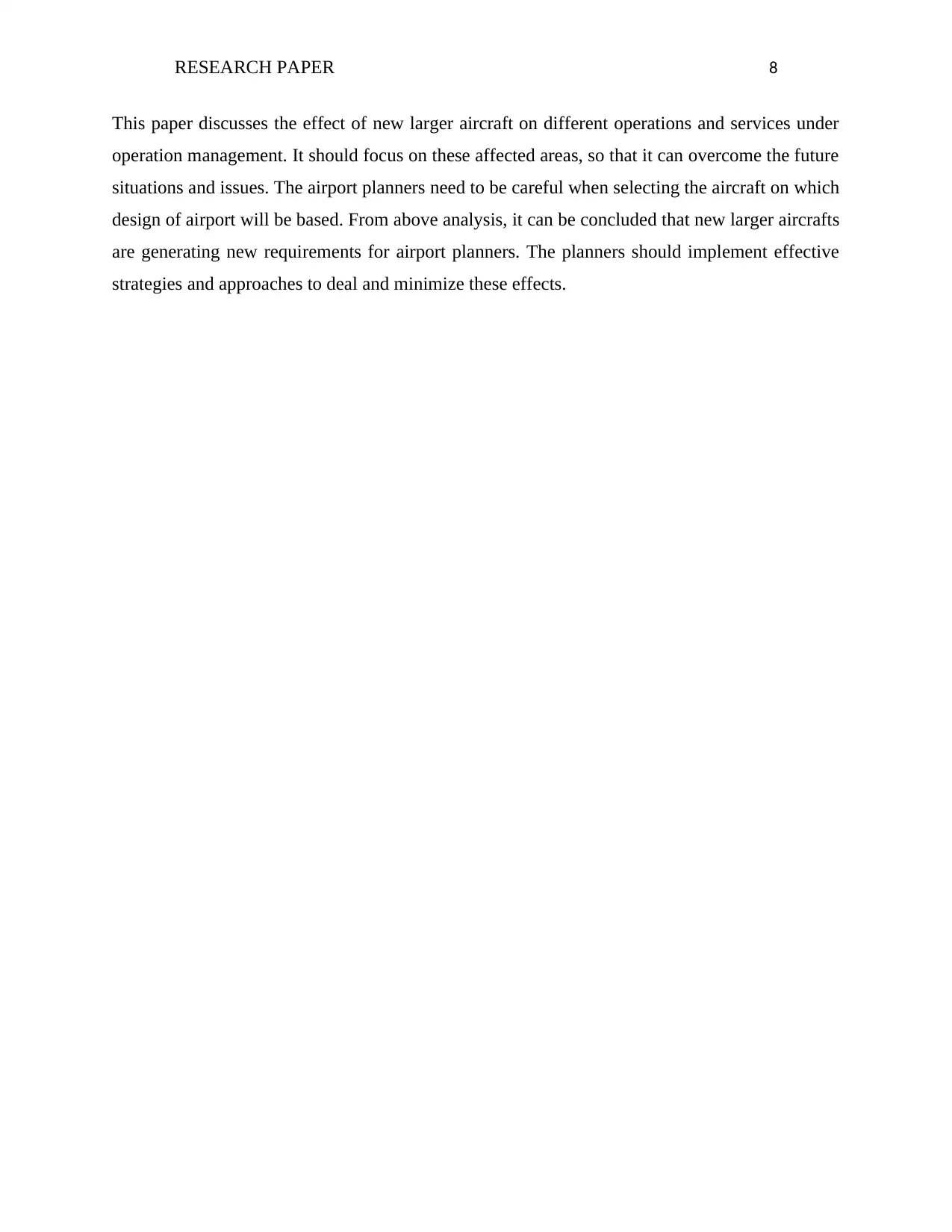
RESEARCH PAPER 8
This paper discusses the effect of new larger aircraft on different operations and services under
operation management. It should focus on these affected areas, so that it can overcome the future
situations and issues. The airport planners need to be careful when selecting the aircraft on which
design of airport will be based. From above analysis, it can be concluded that new larger aircrafts
are generating new requirements for airport planners. The planners should implement effective
strategies and approaches to deal and minimize these effects.
This paper discusses the effect of new larger aircraft on different operations and services under
operation management. It should focus on these affected areas, so that it can overcome the future
situations and issues. The airport planners need to be careful when selecting the aircraft on which
design of airport will be based. From above analysis, it can be concluded that new larger aircrafts
are generating new requirements for airport planners. The planners should implement effective
strategies and approaches to deal and minimize these effects.

RESEARCH PAPER 9
⊘ This is a preview!⊘
Do you want full access?
Subscribe today to unlock all pages.

Trusted by 1+ million students worldwide
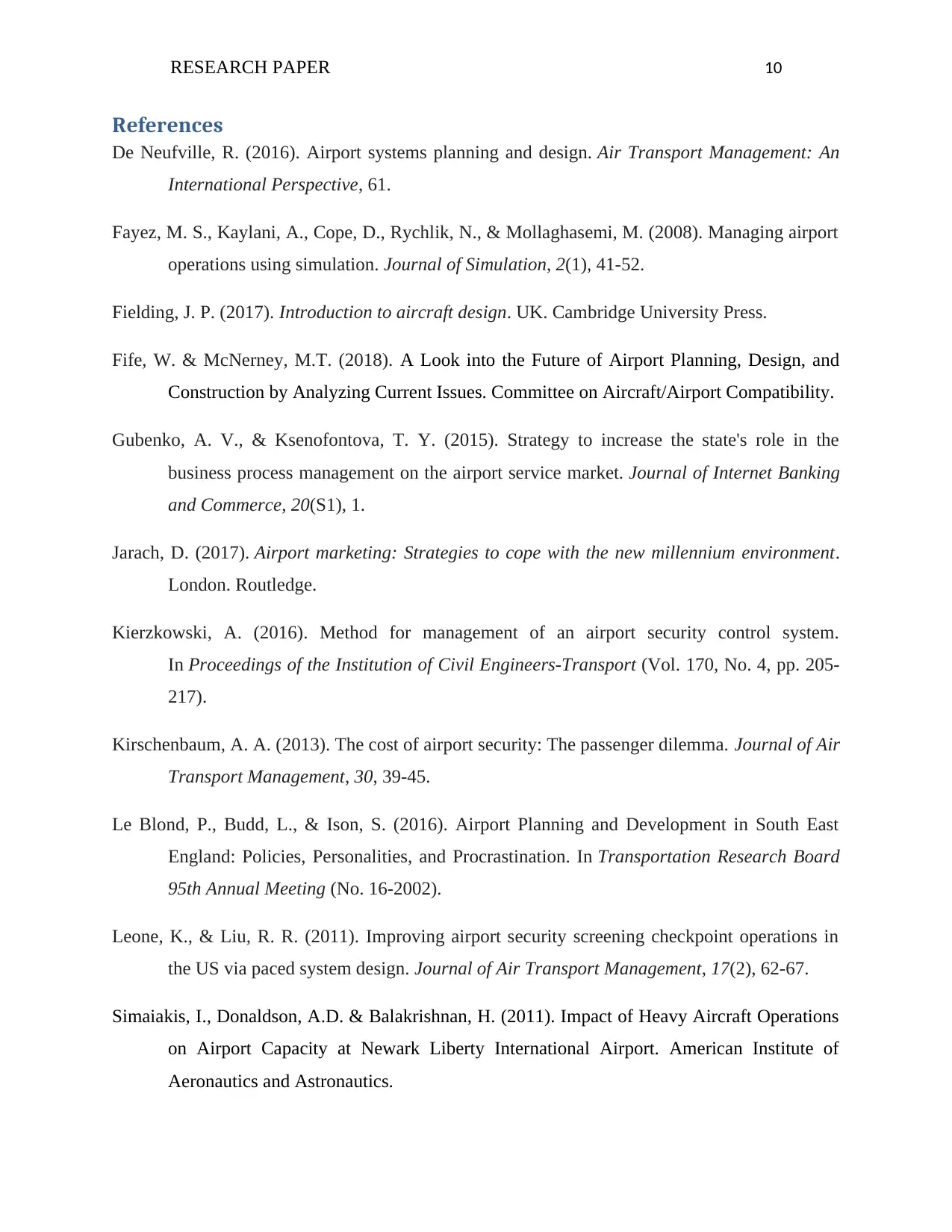
RESEARCH PAPER 10
References
De Neufville, R. (2016). Airport systems planning and design. Air Transport Management: An
International Perspective, 61.
Fayez, M. S., Kaylani, A., Cope, D., Rychlik, N., & Mollaghasemi, M. (2008). Managing airport
operations using simulation. Journal of Simulation, 2(1), 41-52.
Fielding, J. P. (2017). Introduction to aircraft design. UK. Cambridge University Press.
Fife, W. & McNerney, M.T. (2018). A Look into the Future of Airport Planning, Design, and
Construction by Analyzing Current Issues. Committee on Aircraft/Airport Compatibility.
Gubenko, A. V., & Ksenofontova, T. Y. (2015). Strategy to increase the state's role in the
business process management on the airport service market. Journal of Internet Banking
and Commerce, 20(S1), 1.
Jarach, D. (2017). Airport marketing: Strategies to cope with the new millennium environment.
London. Routledge.
Kierzkowski, A. (2016). Method for management of an airport security control system.
In Proceedings of the Institution of Civil Engineers-Transport (Vol. 170, No. 4, pp. 205-
217).
Kirschenbaum, A. A. (2013). The cost of airport security: The passenger dilemma. Journal of Air
Transport Management, 30, 39-45.
Le Blond, P., Budd, L., & Ison, S. (2016). Airport Planning and Development in South East
England: Policies, Personalities, and Procrastination. In Transportation Research Board
95th Annual Meeting (No. 16-2002).
Leone, K., & Liu, R. R. (2011). Improving airport security screening checkpoint operations in
the US via paced system design. Journal of Air Transport Management, 17(2), 62-67.
Simaiakis, I., Donaldson, A.D. & Balakrishnan, H. (2011). Impact of Heavy Aircraft Operations
on Airport Capacity at Newark Liberty International Airport. American Institute of
Aeronautics and Astronautics.
References
De Neufville, R. (2016). Airport systems planning and design. Air Transport Management: An
International Perspective, 61.
Fayez, M. S., Kaylani, A., Cope, D., Rychlik, N., & Mollaghasemi, M. (2008). Managing airport
operations using simulation. Journal of Simulation, 2(1), 41-52.
Fielding, J. P. (2017). Introduction to aircraft design. UK. Cambridge University Press.
Fife, W. & McNerney, M.T. (2018). A Look into the Future of Airport Planning, Design, and
Construction by Analyzing Current Issues. Committee on Aircraft/Airport Compatibility.
Gubenko, A. V., & Ksenofontova, T. Y. (2015). Strategy to increase the state's role in the
business process management on the airport service market. Journal of Internet Banking
and Commerce, 20(S1), 1.
Jarach, D. (2017). Airport marketing: Strategies to cope with the new millennium environment.
London. Routledge.
Kierzkowski, A. (2016). Method for management of an airport security control system.
In Proceedings of the Institution of Civil Engineers-Transport (Vol. 170, No. 4, pp. 205-
217).
Kirschenbaum, A. A. (2013). The cost of airport security: The passenger dilemma. Journal of Air
Transport Management, 30, 39-45.
Le Blond, P., Budd, L., & Ison, S. (2016). Airport Planning and Development in South East
England: Policies, Personalities, and Procrastination. In Transportation Research Board
95th Annual Meeting (No. 16-2002).
Leone, K., & Liu, R. R. (2011). Improving airport security screening checkpoint operations in
the US via paced system design. Journal of Air Transport Management, 17(2), 62-67.
Simaiakis, I., Donaldson, A.D. & Balakrishnan, H. (2011). Impact of Heavy Aircraft Operations
on Airport Capacity at Newark Liberty International Airport. American Institute of
Aeronautics and Astronautics.
Paraphrase This Document
Need a fresh take? Get an instant paraphrase of this document with our AI Paraphraser

RESEARCH PAPER 11
Stewart, M. G., & Mueller, J. (2014). Cost-benefit analysis of airport security: Are airports too
safe?. Journal of Air Transport Management, 35, 19-28.
Wilke, S., Majumdar, A., & Ochieng, W. Y. (2014). Airport surface operations: A holistic
framework for operations modeling and risk management. Safety Science, 63, 18-33.
Wu, C. L. (2016). Airline operations and delay management: insights from airline economics,
networks and strategic schedule planning. London. Routledge.
Zhang, T., Ouyang, Y., & He, Y. (2008). Traceable air baggage handling system based on RFID
tags in the airport. Journal of Theoretical and Applied Electronic Commerce
Research, 3(1).
Stewart, M. G., & Mueller, J. (2014). Cost-benefit analysis of airport security: Are airports too
safe?. Journal of Air Transport Management, 35, 19-28.
Wilke, S., Majumdar, A., & Ochieng, W. Y. (2014). Airport surface operations: A holistic
framework for operations modeling and risk management. Safety Science, 63, 18-33.
Wu, C. L. (2016). Airline operations and delay management: insights from airline economics,
networks and strategic schedule planning. London. Routledge.
Zhang, T., Ouyang, Y., & He, Y. (2008). Traceable air baggage handling system based on RFID
tags in the airport. Journal of Theoretical and Applied Electronic Commerce
Research, 3(1).
1 out of 11
Your All-in-One AI-Powered Toolkit for Academic Success.
+13062052269
info@desklib.com
Available 24*7 on WhatsApp / Email
![[object Object]](/_next/static/media/star-bottom.7253800d.svg)
Unlock your academic potential
© 2024 | Zucol Services PVT LTD | All rights reserved.
